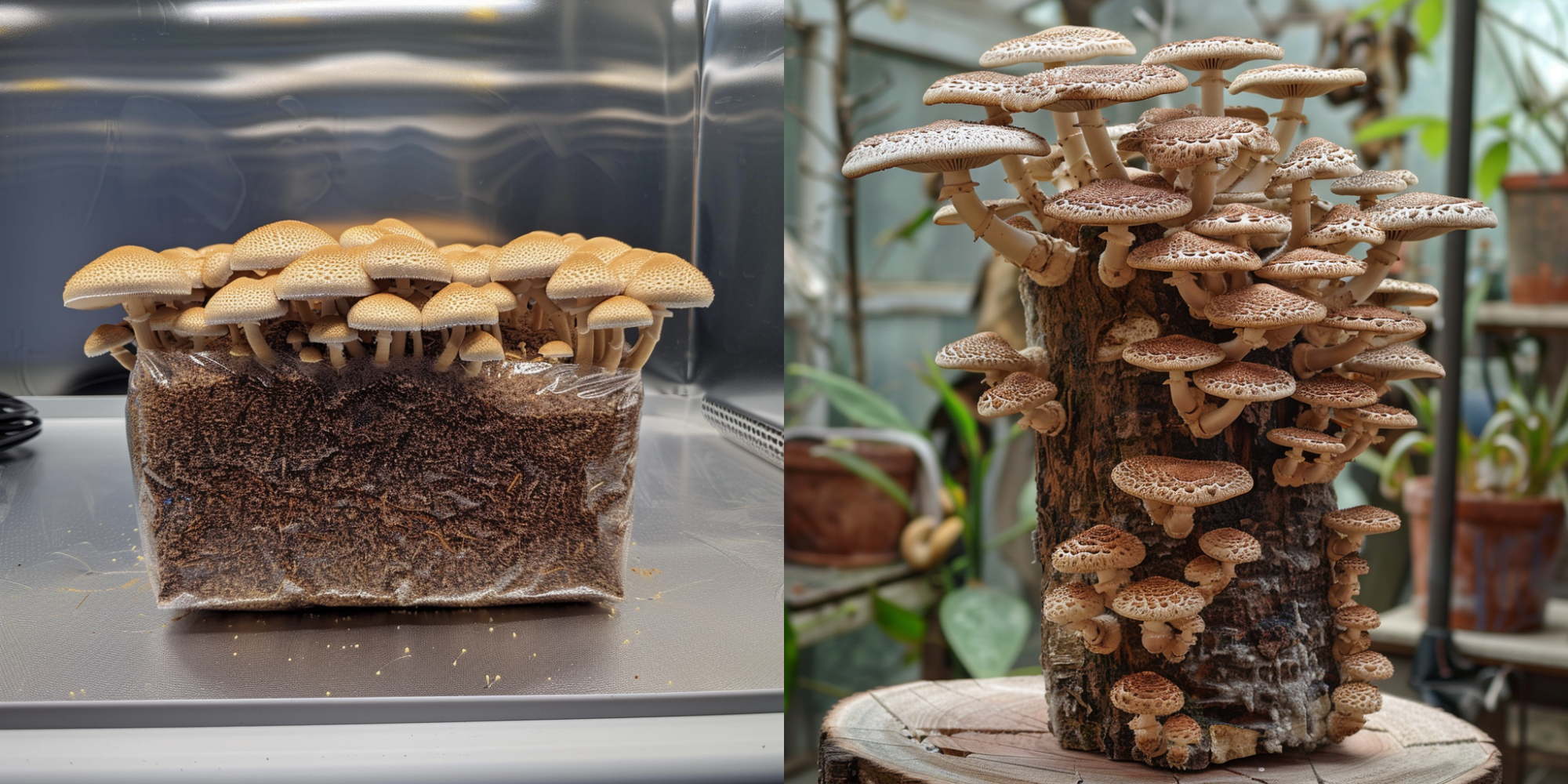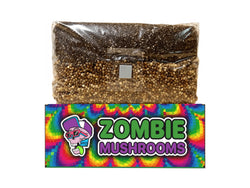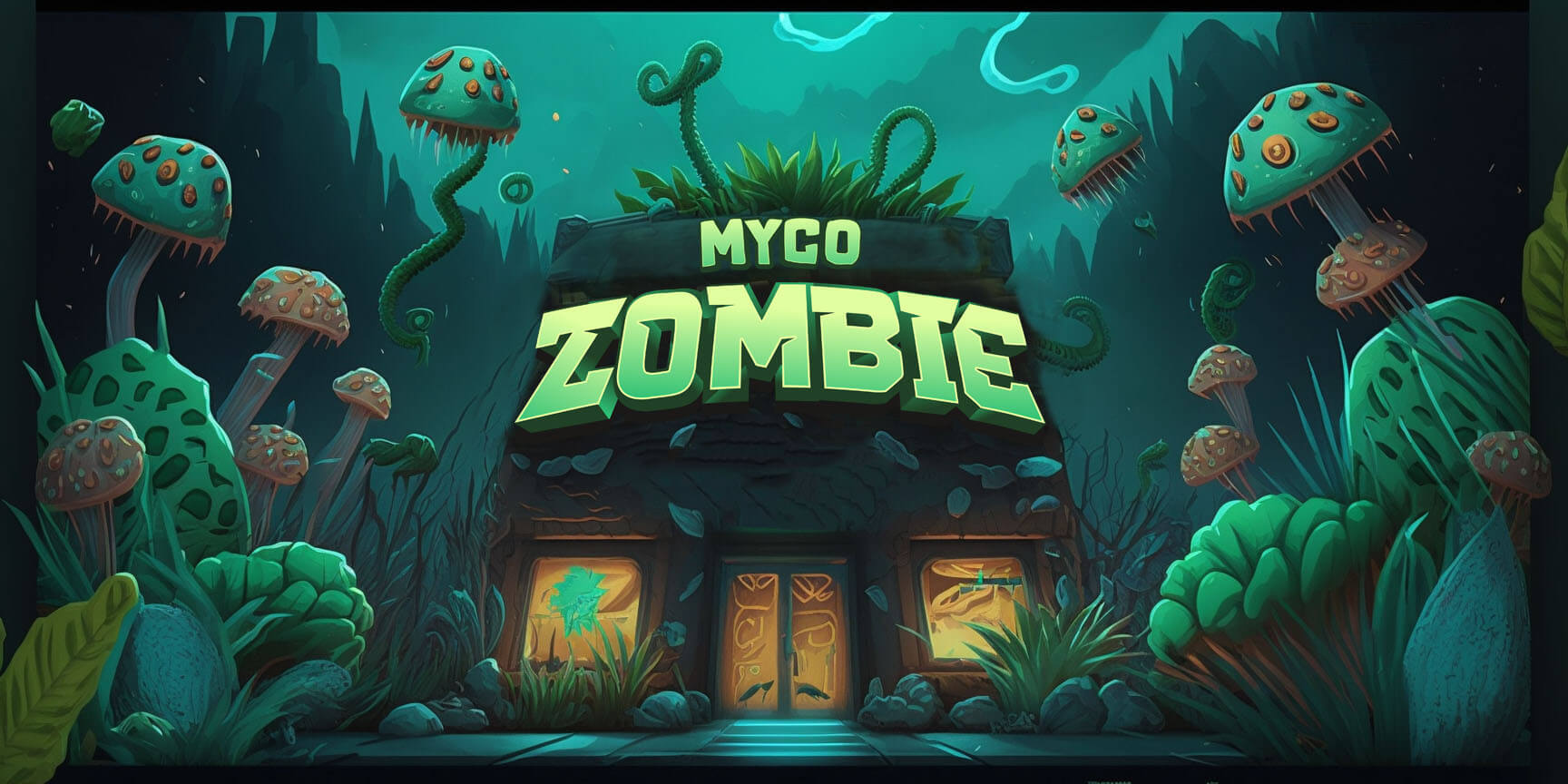Knowing What Mushroom Grain Bags Are

Mushroom growing is becoming popular among mushroom enthusiasts and businesses alike because it's highly nutritional and is widely used for culinary purposes. There are different ways to cultivate mushrooms, both have advantages and disadvantages. This is a quick and thorough comparison of mushroom grain bags and some traditional mushroom growing techniques, like utilizing logs, straw, and sawdust. We are here to help you pick the best method that will match your needs.
The usage of grain bags is a common method for mushroom cultivation. It's best for newbies. The bags have sterilized grain commonly millet, rye, or wheat that has mushroom spawns introduced to them. These bags give a controlled environment best for the mycelium to colonize and start fruiting.
Advantages of Using Grain Bags:
They are easy to use
These bags are prepared with all the materials you need inside. The bags come with step-by-step instructions too which is why they're great for new mushroom growers.
Maintains High Levels of Sterility
The contents of the bag and the bag itself are sterilized and then sealed avoiding any risk of contamination.
It's Portable
Grain bags boast of mobility as these can be moved around with great ease,in a location best fit for optimal growth.
A High Degree of Control
Since it's already encased in a bag. You would easily have control of humidity and temperature levels.Disadvantages of Using Mushroom Grain Bags:
They're Generally Smaller
Typical Grain Bags are smaller in size which means that they may not be your best option if you're planning to do large-scale production without using several bags
They're Expensive
These bags are premade which is why they cost more than some substrates. You may be able to save if you could make DIY ones.
Growing Mushrooms Using Logs
One of the oldest techniques in growing mushrooms is the use of logs. This is commonly used for growing shiitake and reishii mushrooms. These logs are inoculated with mushroom spores that colonize the log. The process typically takes a good few months to a year.
Advantages of Log Cultivation:
Natural Substrate
Logs provide a natural environment for many types of mushrooms.
They Lasts Long
When fully set, these logs will yield big for years.
Needs less Intervention
You only set it up once, since it doesn't require much handling and intervention.
Disadvantages of Log Cultivation:
Growth is slow
The process of colonization takes time usually taking months to a year. It's not an option if you don't like time-consuming methods.
Not for Indoors
The use of logs for mushroom cultivation requires space and that means it can't be set up indoors.
It's Physically Demanding
Using Logs as mediums to grow mushrooms can be labor intensive since you do have to prepare the logs and inoculate them.
Using Blocks of Sawdust

This is another substrate that is typically used by mushroom cultivators. These are created from hardwood sawdust and other organic materials that are organically derived. These are made into blocks and go through sterilization before they get inoculated.
Advantages of Using Sawdust Blocks:
Versatility
These blocks are highly versatile they can be a good medium in growing different types of mushrooms such as shiitake, oyster and even lion's mane.
Bigger Yield
Sawdust Blocks are able to yield big volumes of mushrooms.
Provides Controlled Environment
Just like their grain bag counterpart they both boasts of providing a controlled environment geared towards optimum growth.
Disadvantages of Sawdust Blocks:
It's Time-Consuming
Sawdust blocks need to be properly sterilized and prepared before use, which can be both labor-intensive and time-consuming.
The Overall Cost
Even if the materials don't cost as much the preparation and the process that entails can have additional cost.
Easily Contaminated
These blocks are prone to contamination if they have not undergone proper sterilization.
Using Straw 
Straw is a substrate known to be used in growing oyster mushrooms. The straw goes through pasteurization and is sterilized before mushroom spawn is introduced.
Advantages of Using Straw:
Cost-Efficiency
Straw is inexpensive and is available everywhere.
Colonizes quickly
Fruiting is faster with the use of straw.
Yields Big
Even in a short period, mushrooms grown using straw produces high yields.
Disadvantages of Using Straw:
It's Labor-Intensive
Because straw needs to be pasteurized and sterilized first preparation can be time-consuming and would take a lot of work.
It Needs Space
The same as using logs, the usage of straws requires space.
Prone to Contamination
Utmost preparation is needed before using straw since it can easily get contaminated without proper preparation.
Using Monotubs

Monotubs are a simple and efficient system for growing mushrooms especially for the amateurs and small commercial producers. They are some types of plastic boxes that are used for growing of the mushroom to the desired platform.
It offers great environmental control that offers large yields, that is, a controlled climate of humidity, fresh air and light.
Advantages of Using Monotubs
Scalability
Essential features such as size are easy to adjust to higher or lower levels, so a monotub can be used by novices as well as advanced users.
Controlled Environment
They promote proper colonization of mycelium and the development of mushroom fruiting bodies thereby enhancing the outcomes of yield.
Cost-Effectiveness
It is inexpensive to set up a monotub as a growing method compared to other arrangements. Most materials are fairly accessible.
Easy Maintenance
After setting them up, monotubs do not necessarily demand much attention. Misting and proper airflow are most often adequate remedy as a reaction to wet indoor environment and growth of mold and mildew.
High Yield Potential
Monotubs can cultivate many mushrooms compared to their size thus suitable for small-scale production.
Disadvantages of Using Monotubs:
Space Requirements
Although they are not large structures, several monotubs can occupy a rather large area, which can be a limitation for some producers.
Contamination Risk
Contamination can arise from poor sterilization, inadequate ventilation, or even poor conducting of the batch, which would mean a total loss of batch.
Initial Setup
Some amount of alterations have to be made by the users in the tub through drilling holes and the process may be involved if the users lack the technical know-how in handling the tools.
Monitoring
It appears that constant monitoring is needed for the humidity and ventilation level which may take a lot of time.
Learning Curve
It can take some time to get the right balance involving conditions like humidity, the external temperature, and the right airflow.Monotubs are perfect when it comes to growing mushrooms at home because it is efficient and very easy. Thus, by knowing the pros and cons, one is in a better position to master all that is needed to make the mushroom farming a success.
Quick Comparison
Here's a quick comparative guide on the pros and cons of each method in multiple contexts:
Simplicity
-
Grain Bags
Designed for newbies because it can give a contained environment that can be easily adjusted and controlled. -
Logs
To properly use logs for mushroom cultivation you need to be knowledgeable and willing to exert effort physically. -
Sawdust Blocks
They are difficult to use because of preparation requirements before use. -
Straw
Same as Sawdust Blocks these take time and effort to prepare.
Their Costs
-
Grain Bags
These bags tend to be more expensive when bought since they typically come premade. -
Logs
Logs don't cost much if you have access to hardwood that's suited for mushroom cultivation. -
Sawdust Blocks
Materials are inexpensive but the preparation costs more. -
Straw
Highly inexpensive.
Space Needed
-
Grain Bags
Since they're small, they don't need much space and are great for indoors. -
Logs
It needs space outdoors, which is not something available if you live in apartments. -
Sawdust Blocks
Although these can also be used indoors they take more space than grain bags. -
Straw
You need space if you plan on using this since these are commonly set and used in large spaces.
Harvest Results and Performance:
-
Grain Bags
Good for constant supply, perfect for home use or those who do not produce large amounts of tea. -
Logs
Long-term yield within some years, ideal for the growers having an outdoor area. -
Sawdust Blocks
High yield and recommended for Large-scale production or medium production. -
Straw
Good for high producing rates in a short amount of time; useful in high turnover settings.
Maintenance:
-
Grain Bags
Able to be maintained at a low level once inoculated. -
Logs
Minimal maintenance work to be done once it has been installed. -
Sawdust Blocks
Low-Medium, mostly during the initial assembly of the Shadow PC. -
Straw
It can be classified as moderate because of preparation and more frequent check-ups.
Suitability for Different Kinds of Mushrooms
Some species of mushrooms are known to have a preference where they can grow hence some of the methods may be appropriate than others.
-
Grain Bags
Illustrated as appropriate for mushrooms such as oyster, shiitake, and lion’s mane because of the rapid growth of these types of mushrooms. -
Logs
Very suitable for the shiitake, reishi, and other sorts of mushrooms that love woods. -
Sawdust Blocks
It is universal, applicable for oyster, shiitake, and lion’s mane mushrooms. -
Straw
Mainly employed with oyster mushrooms because of the speed at which they colonize the substrate.
Sustainability
Recall that environment is also another critical factor that should be considered in Mushroom farming among which biodegradable packing plays a major role.
-
Grain Bags
They produce only plastic waste unless it is recycled or given another new function, and the substrate is bio-degradable. -
Logs
The units are also environmentally friendly particularly when using fallen trees or waste wooden material. -
Sawdust Blocks
It can be if sawdust results from the waste wood, yet, preparing it takes a lot of energy. -
Straw
Sustainable due to the use of agricultural byproducts, although it incorporates energy from pasteurization.
Advanced Techniques in Mushroom Cultivation

whether you are a professional or a beginner in the growth of mushrooms at home. Now, it is the right time to discuss some fun tips for increasing your yields and making your mushrooms perfect.
To grow mushrooms well, it's important to know how they grow: To grow mushrooms well, it's important to know how they grow:
Spores
These tiny seeds lead to mushroom-like growth.
Mycelium
It is like the root system of the mushroom spread through its substrate.
Pinning
This is when tiny pin-like structures appear and adhere to everything in view, which will then turn into mushrooms.
Fruiting
The Mushroom develops and is produced.
Optimizing Your Growing Environment
Getting the environment right is key to successful mushroom growing.These are the things you need to maintain if you're looking to optimize the growing environment of your mushrooms.Temperature Control
Stay on the cool side. It also helps use heaters or fans in order to have an ideal temperature for the growth of your mushrooms.
Humidity Management
It likes humidity, many mushrooms do. Humidity should be checked with an instrument, and water should be added if the latter is low.
Lighting
Certain mushrooms require the sunlight, but it should not be directly on the mushroom. Ordinary grow light is enough for their growth ; hence, they should be provided.
Air Circulation
It is noteworthy that mushrooms require clean air. A small fan doesn’t compromise on the circulation of air while it does not dry out your mushrooms.
Enhancing Your Mushroom Bed

Make your mushroom substrate (the stuff they grow on) even better: Make your mushroom substrate (the stuff they grow on) even better:
Adding Nutrients
Give your substrate a boost by using gypsum, used coffee grounds, or even bran. However, they should be clean to prevent issues arising from the circulation of the money.
Keeping It Moist
The substrate should be wet, but not flooded; it should feel slightly moist to the touch. Watch it and moderate it based on what is required.
Advanced Growing Tricks
Try cool techniques to improve your mushroom growing skills:Try these cool techniques to improve your mushroom-growing skills:Double-Ended Case (DEC)
To boost substrate use vermiculite or an alternative above. It assists in regulating the right amount of humidity and ensuring your mushrooms develop in a balanced manner.
Cold Shock
Some mushrooms prefer some heat to begin germinating. These cuttings would grow faster if you placed your growing bag in the refrigerator for a day.
Casing Layer
Add a top layer of either peat moss or vermiculite on the substrate. It assists in keeping things moist and provides the needed environment for the mushrooms to thrive.
Serial Harvesting
Mushrooms usually come in cycles and when the first cycle arrives it brings along the second cycle. After the first harvest keep conditions favorable for more mushrooms to develop.Fixing Common Problems
At times, plans or tasks can get tricky regardless of such tricks. Here's how to handle them: Here's how to handle them:
Contamination
Do not wait for it to clear up. If mold is appearing, or other bad stuff. It’s important to get rid of the contaminated area to avoid further infection.
Slow Growth
If it’s growing at a very slow rate. You may want to do a quick check. It may need more heat, moisture, or nutrients added to it.
No Mushrooms
Get a cup of water, then put on light or reduce the level of humidity. Mushrooms in a way require specific conditions to be able to grow..
Tall Mushrooms
If in your grow area you notice that you have taller and thinner mushrooms, they could need more light or better air circulation.
Practical Tips for Successful Mushroom Cultivation

Here are practical tips to be considered for maximum success in mushroom cultivation, be it with grain bags or other methods.
Begin with a Clean Space:
Contamination is the biggest issue with mycology and sterile procedures are super important especially when preparing your substrates, and inoculating your spawn. Make sure to sterilize what you need too properly and keep a clean area.
Select the Correct Mushroom Species:
Choose appropriate mushroom species for the cultivation method you have selected. Know the requirements of your chosen mushroom species and local climatic conditions.
Monitor Environmental Conditions:
Be sure to maintain and monitor the growing environment, including monitoring temperature, humidity, and light.
Be Patient and Observant:
Patience and careful observance are necessary for mushroom cultivation. Regularly check the progress of your mycelium, and watch for contamination or other problems. The sooner such problems are found, the easier they will be to correct.
Monitor, Explore, and Learn
The success of your harvest doesn’t solely depend on one substrate, methods used, or the setup you have. Monitor your batch regularly and explore ways on how to further enhance the yield of your harvest. Keep track of your progress regularly.
Cultivating Mushrooms for Culinary and Health Use
The cultivation of mushrooms is an essential component in the fields of mycology and fungal technology.
If you love mushrooms this might make your day - cultivated mushrooms have many benefits and are versatile in the kitchen. Knowing these facts and researching new recipes using mushrooms may bring you closer to your home's produce.
Health Benefits
Not only does it boast of nutrients it also is a great addition to the list of foods you would be able to eat even if you’re on a diet as these are low in calories and is completely free of fat. It also helps fight off sickness as it boosts your immunity and helps your heart become healthier and your body free from inflammation.
Medicinal Use:
A variety of mushrooms are grown for their medicinal benefits common ones include reishi and lion’s mane mushrooms which are popular for their medicinal qualities.
These mushrooms have been used for centuries in Chinese traditional medicine to boost the immune system as well as to lower stress. Others, such as lion’s mane mushrooms, are believed to boost cognitive function and help the nervous system. Eating more mushrooms is a great way to boost your health.
Culinary Versatility:
They’re also fabulous cooked in soup or stew, as an addition to stir-fries or salads, or fried and served simply on toast. Crimini, which are quite meaty, make a great hot pot, or can simply be pan-fried with onion and garlic and served with rice. And the pure white Michigan morels are best at the beginning of the season when fried on their own in butter with a sprinkle of parsley. In either case, try a recipe or two, see what works for you, and enjoy the fruits of your labor.
Conclusion
Choosing the right method for mushroom cultivation depends on your goals, resources, and preferences.
Here’s a summary to help you decide:
Grain Bags
For the beginner and those with the least amount of space, looking for deliberate control and consistent return.
Logs
Ideal for hobbyists with outdoor space looking for a long-term, low-maintenance option.
Sawdust Blocks
Suitable for those with intermediate to advanced experience who want high yields and don’t mind the preparation.
Straw
Good for people who want a cheap and fast-yielding crop (for example, oyster mushrooms) but bad for those who don’t want to dig holes everywhere to pick out all the straw.
Every method has some challenges and some advantages, so the right way for you depends on what it is you want to grow and how, and your home or operation setup. Whether you are a beginner just reading about mushrooms for the first time, or an experienced mushroom farmer, understanding the differences can help you to decide what the right method for mushroom cultivation will be for you.





